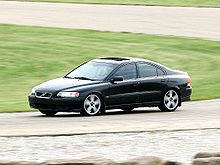Understeer

Understeer is a term from driving dynamics that is used to describe self-steering behavior . It describes the fact that when cornering, the greater the steering wheel angle, the faster the radius is traveled.
In modern electronic stability programs (ESP), the actual movement variables are compared with the “driver's request” derived from the steering wheel angle and the driving speed using the internal single-track model . If the driver wants to “drive more corners” than actually measured, understeer is recognized. If the deviations are too large, the inside rear wheel is automatically braked and the engine power is reduced.
The opposite of understeer is oversteer . With a constant radius, the steering wheel angle must be reduced as the lateral acceleration increases. For safety reasons, all vehicles today are designed to understeer throughout. The front axle reaches the slip limit first . The traction potential is not used on the rear axle, which limits the float angle . In addition, the vehicle brakes by "pushing" the front wheels, which means that a narrower radius can be traveled again.
However, a design in which the understeer can suddenly change to oversteer is considered to be structurally unsafe: when a rear wheel loses its static friction. Such a design can lead to accidents, especially with inexperienced drivers. This danger is particularly present in vehicles with strong rear-wheel drive: accelerating in bends can lead to the rear breaking out of the vehicle, as the relieved inner wheel starts to spin and thus loses its cornering ability.
Contrary to popular belief, the understeer behavior does not only have an effect in the limit range , but also from medium speeds on during normal driving. Among other things, it influences the impression of agility . An understeering design is essential for stable driving behavior.
definition
According to DIN ISO 8855, understeer occurs when the difference in the gradients of the steering angle and the Ackermann angle with respect to the lateral acceleration is greater than zero during stationary circular travel .
The basis of the evaluation is a diagram in which the steering angle and the Ackermann angle are shown as a function of the lateral acceleration. The Ackermann angle is constant on a constant curve radius, so the driver has to turn the steering wheel more as the lateral acceleration increases. This definition according to Bergmann is based on the terms of the single-track model and describes the self-steering behavior over the entire lateral acceleration range. In contrast, in racing, often only the behavior at the adhesion limit (slip limit) is considered. A vehicle is referred to as understeering if the front axle reaches the slip limit first. The lateral acceleration can no longer be increased by turning the steering wheel further.
Web links
Individual evidence
- ↑ Erich Schindler: Driving dynamics: Fundamentals of steering behavior and their application for vehicle control systems . expert verlag, 2007, ISBN 978-3-8169-2658-0 , p. 34 . ( limited preview in Google Book search)
- ^ Karl-Ludwig Haken: Fundamentals of automotive engineering . 4th edition. Hanser, 2015, ISBN 978-3-446-44216-0 , pp. 252 . ( limited preview in Google Book search)




